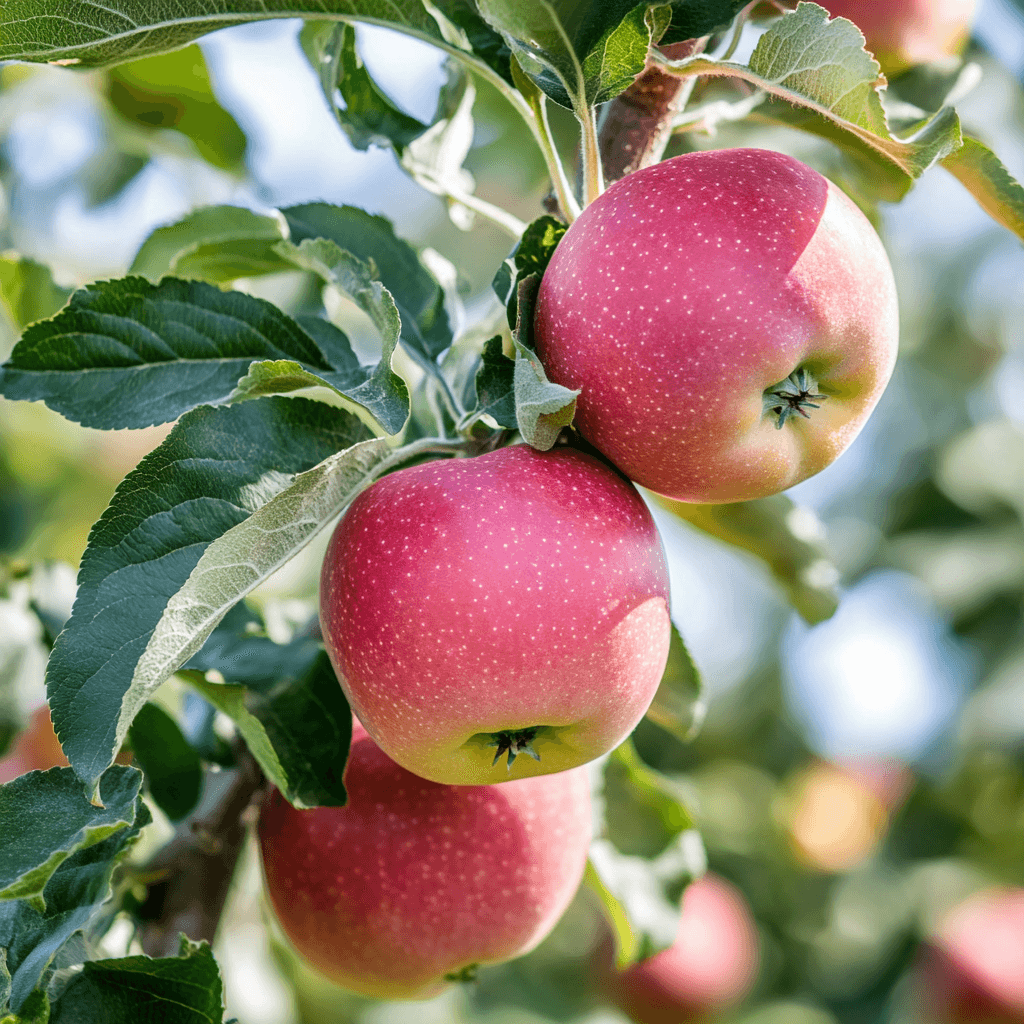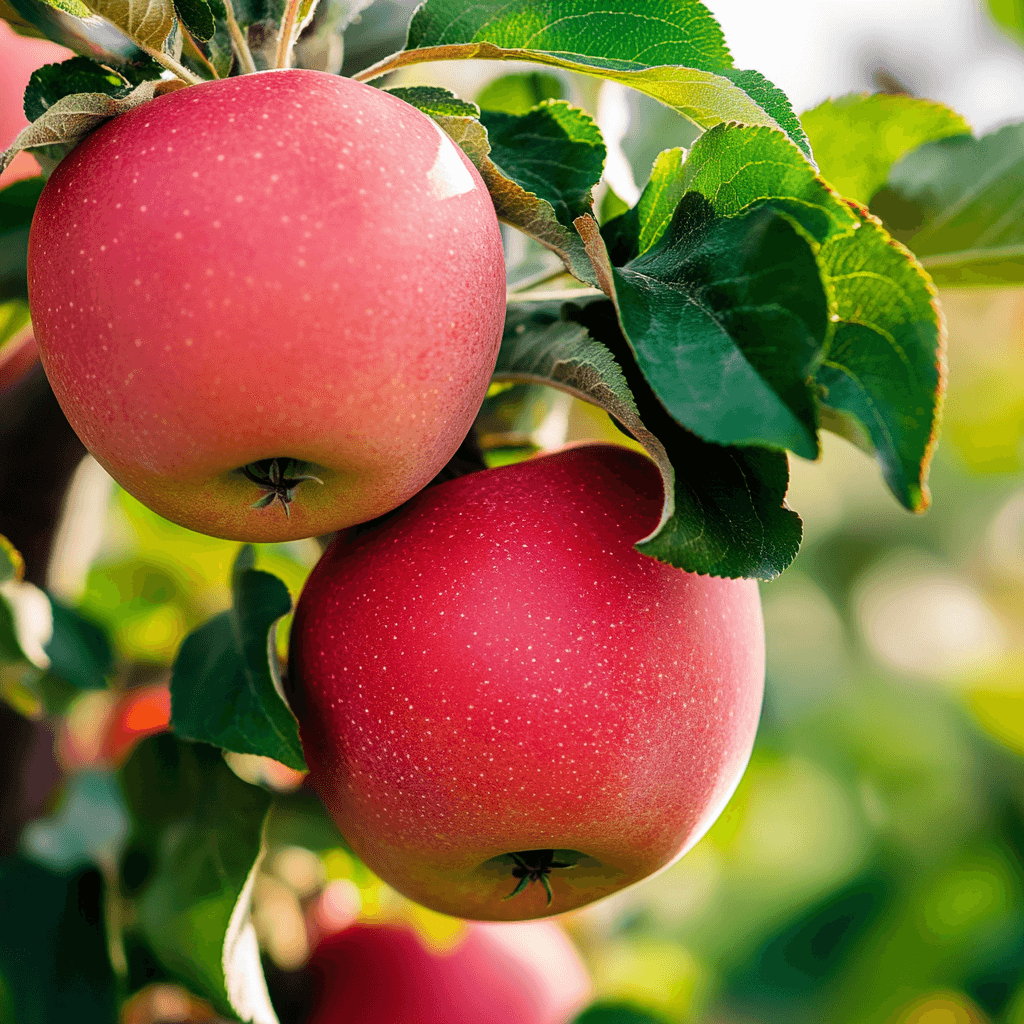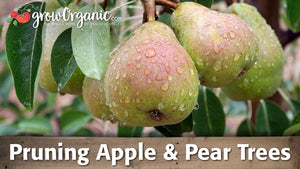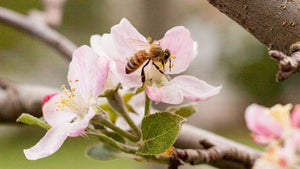Item Number: FT030
Fuji Red Apple Tree
Juicy sweetness that lasts.
Fuji Red apple trees are renowned for their large, crisp apples with exceptional sweetness and juicy texture. The red-blushed fruit is perfect for fresh eating, baking, or adding to salads. Fuji apple trees are also known for their excellent storage capability, retaining their flavor and texture for months. The tree thrives in full sun and well-drained soil, requiring moderate chill hours. Red Fuji apple tree is partially self-fruitful but benefits from a pollinator, such as Golden Delicious or Dwarf Honey Crisp, for better yields. With its robust growth, reliable productivity, and superior fruit quality, Fuji Red is a favorite for home orchards and commercial growers alike.
Dwarf on M-111 rootstock.
-
Zones: 5-9
-
Chill hours: < 500
-
Bloom Time: Late (Based on typical Central Valley California weather)
-
Harvest: September 20 - October 7
-
Looks: Reddish-orange skin.
-
Personality: Very crisp, sweet and flavorful.
-
Facts of note: Taste Test Top Scorer. Low chill hours, good choice for milder climates. Good keeper. Developed in the 1940's in Japan and has since become California's favorite apple. It is widely grown in China, the world's largest apple growing region, accounting for 70% of production. Trees begin to fruit in 3 years.
-
Pollination: Self-fruitful and best pollenizer for other varieties
Growing Fuji Apple Trees: A Guide to Cultivating Your Orchard
Fuji apple trees, known for their crisp texture and sweet flavor, have become a favorite among home gardeners seeking a delicious addition to their orchards. This guide provides comprehensive insights into growing Fuji apple trees, offering valuable tips and step-by-step instructions to help you cultivate healthy and fruitful trees. As part of the apple association, it's important to understand the care needed for Malus domestica Fuji to thrive, including how to avoid freezing temperatures in winter and protect the trees from extreme heat during the summer months for optimal growth.
Selecting the Right Site:
Before delving into the planting process, it's crucial to choose an ideal location for your Fuji apple trees. These trees thrive in well-drained soil with a slightly acidic to neutral pH. Select a site with full sun exposure, ensuring the trees receive at least six to eight hours of sunlight daily. Adequate sunlight not only promotes healthy growth but also enhances fruit quality.
Preparing the Soil:
Fuji apple trees prefer soil that is rich in organic matter. Prepare the planting site by incorporating compost or well-rotted manure into the soil. This enhances fertility and provides the necessary nutrients for robust tree development. Ensure proper drainage to prevent waterlogged conditions, which can be detrimental to the trees.
Choosing the Right Tree:
Selecting a healthy Fuji apple tree is paramount for successful cultivation. When purchasing a tree, opt for a one-year-old whip or a two-year-old tree with a well-established root system. Inspect the tree for signs of diseases or pests, and choose disease-resistant varieties whenever possible.
Planting Fuji Apple Trees:
Planting Fuji apple trees requires careful attention to detail. Begin by digging a hole twice the width of the root ball and at a depth that accommodates the entire root system. Place the tree in the center of the hole, ensuring it stands upright. Backfill the hole with soil, gently firming it around the roots. Water the tree thoroughly after planting to settle the soil.
Pruning and Training:
Proper pruning is essential for shaping Fuji apple trees and encouraging optimal fruit production. Begin by removing any dead, damaged, or crossing branches. Focus on creating an open canopy that allows sunlight to penetrate, promoting even fruit ripening. Additionally, consider training the tree using appropriate methods such as central leader or modified central leader systems.
Watering and Fertilizing:
Establish a consistent watering schedule, especially during dry periods. Deep watering is preferable to encourage deep root growth. Apply a balanced fertilizer in early spring, adjusting the amount based on the tree's age and overall health. Monitor nutrient levels regularly and make necessary adjustments to ensure optimal growth.
Ripening
Fuji apples, belonging to the diverse family of apple varieties, have gained popularity for their crisp texture and sweet flavor. Understanding the ripening process of Fuji apples involves delving into the intricate workings of plant biology.
The journey to that perfect crunch begins with the cell wall. As apples mature, the cell walls undergo changes, softening and transforming the texture. Plant hormones, such as ethylene, play a crucial role in signaling the ripening process. This natural plant hormone acts as a messenger, orchestrating the production of enzymes that break down cell wall components. This orchestrated dance of enzymes is what brings about the delightful transition from firmness to crispness in Fuji apples.
Fruit maturity is a complex interplay of factors. It's not just about the sugars developing, but also about the balance of acids and tannins. As Fuji apples reach their peak, the sugars increase, providing that perfect sweetness. Meanwhile, acids decrease, contributing to the harmonious flavor profile. Tannins, responsible for astringency, diminish, ensuring a pleasant eating experience.
All these transformations are orchestrated by the tree's roots. The roots absorb water and nutrients from the soil, channeling them to the developing apples. This vital connection between roots and fruit ensures the steady supply of resources needed for the ripening process. The synergy of plant processes culminates in the Fuji apple's journey from bloom to harvest, offering a delightful and crunchy treat for apple enthusiasts.
Pest and Disease Management:
Fuji apple trees are susceptible to various pests and diseases, including aphids, apple maggots, and apple scab. Implement integrated pest management strategies, such as introducing beneficial insects and using organic pesticides when necessary. Regularly inspect the trees for any signs of diseases, and promptly address any issues to prevent their spread.
Thinning Fruit:
To ensure the development of high-quality fruit, practice thinning during the growing season. Remove excess fruit when they are still small, leaving an adequate space between the remaining apples. Thinning promotes larger, healthier fruit and prevents branches from breaking due to the weight of an excessive crop.
Harvesting Fuji Apples:
Fuji apples are typically ready for harvest in late fall. Monitor the color and firmness of the fruit to determine their ripeness. Harvest apples by gently twisting them or cutting the stem with pruning shears. Store harvested apples in a cool, dark place to prolong their shelf life.
Cultivating Fuji apple trees is a rewarding endeavor that can result in a bountiful harvest of crisp, sweet apples. By following these guidelines, you can create a thriving orchard and enjoy the satisfaction of growing your own delicious fruit. From site selection to harvest, each step plays a crucial role in the success of your Fuji apple trees. Embrace the journey of orchard cultivation, and soon you'll be relishing the delightful taste of homegrown Fuji apples.
Why Buy Fuji Apple Tree From Us?
When you choose a Fuji apple tree for sale from us, you’re getting a high-quality apple tree that produces the sweet, crisp ripe fruit that has made the red Fuji apple tree a favorite among gardeners. Our trees are carefully cultivated to ensure healthy growth, whether you plant them in the ground or a container, and we provide detailed care instructions, including tips on pollination, mulch, and pruning. Developed through extensive research station efforts and a cross involving varieties like Red Delicious, these deciduous fruit trees are sure to thrive in your garden, providing delicious apples well into the winter, while also being disease-resistant to prevent disease for long-term success.
Visit our Fruit Tree Central for a listing of all our fruit tree videos and articles.
Visit Tree Characteristics for a listing of all our fruit & nut tree growing characteristics.
For more information about different types of rootstocks and how they influence tree size and growth, see our Tree Rootstock Characteristics Chart.



Check Your Zone Compatibility:
Compatible with your zone.
Growing Zone for

Our Guarantee To You
Since 1976, we've served our customers at every stage of growing. Please contact us at any time. We are happy to support and assist you.
Shipping Information
Shipping Information
Cannot ship to the following states: HI, AK, PR, GU, VI
Shipping Weight: 5.0 lb
Dimensions: 47.5"L x 7.3"W x 2.75"H
Features
Features
- Bare Root
- Flavor Pick
- Good Keeper
- Self-fruitful
- Suited to Warmer Climates
Characteristics
Characteristics
Planting & Care
Planting & Care
Useful Information
Useful Information
Guarantee
Guarantee
Limited Dormant Tree & Plant Guarantee
* Claim deadline is June 15th
We guarantee that your dormant tree or plant will arrive in good, viable condition. If your tree arrives in substandard condition, notify us within 3 days of delivery. Please email pictures of the box, inside packaging, the tree and its roots to helpdesk@groworganic.com. We will investigate your claim and process a request to exchange or refund the damaged product.
If your dormant tree or plant has not grown new leaves by June 15th, you may be eligible for our Limited Dormant Tree & Plant Guarantee. This guarantee provides for a store credit for the purchase price of the tree, excluding shipping. Please see the Instructions below.
Important Dates:
- April 1st Dormant trees/plants must be planted in the ground
- May 15th Perform scratch test, if no new leaves have grown
- June 15th Deadline to apply for a dormant tree/plant credit
All required documentation must be received by June 15th for your claim to be considered. Claims or documentation received after June 15th will be denied, without exception. Instructions listed below
Terms and Conditions
We cannot guarantee that your tree or plant will remain alive and healthy after it is received, or bear fruit as there are too many variables in your environment that are beyond our control (i.e. soil preparation, weed and pest control, proper irrigation, chill hours, compatible hardiness for your growing zone, proper choice of pollinator, extreme weather, rodent damage, disease, etc.).
We cannot guarantee that we will be able to provide a replacement tree/plant of the same species either that same growing season or in future years. Customers are responsible for all shipping fees associated with replacement trees and plants.
If we determine that the tree you purchased directly from us is not viable, we will issue you a store credit (not a refund) for the purchase price of the affected dormant tree or plant. Shipping is not included in the dormant tree/plant guarantee. Store credits can be used to purchase any product we sell and are valid for use only until July 1st of the following year.
Historically, 98% of our dormant trees and plants grow and thrive when they have been cared for and planted using our growing guides. Dormant trees and plants must be planted in the ground by April 1st in order to be eligible for credit. If the ground in your area is still frozen solid, you may temporarily plant your tree or plant in a pot.
Potted, non-dormant trees or plants are excluded from this guarantee as they are not dormant at the time of shipment. Evergreen trees such as citrus, avocado and olive trees are not available for credit under the Dormant Tree and Plant Guarantee.
Instructions
We guarantee that your dormant fruit tree or plant will leaf out, if you care for it according to our growing guides. In the unlikely event that your dormant tree or plant does not have leaves by May 15th, follow these simple steps to apply for a store credit:
Before you call or email, please perform a “scratch test” to determine if the tree or plant is still alive. This video shows how to check for live tissue under the bark. Scratch tests need to be done a few inches above and below the graft.
Green Cambium Layer / Living Trees
If the cambium layer under the bark is green, give your tree a little more time. It is still alive, but hasn’t come out of dormancy yet. Check to make sure that it is getting the right amount of deep root water, enough sunlight and that the weather is warm enough for that type of tree/plant to come out of dormancy. Every tree has its own personality and will come out of dormancy at different times. Be sure to submit the required documentation listed below by June 15th, if it doesn’t grow leaves.
Brown Cambium Layer / Dead Trees
If the scratch test shows a brown cambium layer or if your dormant tree/plant doesn’t have leaves by June 1st, please email us at helpdesk@groworganic.com. All required documentation listed below must be received by June 15th for your claim to be considered. To be considered for the guarantee claim, all required documentation must be received by June 15th. Incomplete submissions will be denied.
Required Documentation
- Order number
- Name of dormant tree/plant and the quantity affected
- Photos of each tree or plant showing:
- The roots (tree or plant must be pulled out of the ground)
- The scratch test areas
- The entire tree/plant
We reserve the right to not issue credit for items that have already been replaced. We also reserve the right to require photographic evidence that the tree/plant was not killed by root rot, rodent or mechanical damage.
Share






I love the shape and how strong this one is growing. It looks fantastic. Perfectly shaped, holding out through our Texas heat.
Received this and another tree. The Fuji tree only had three branches, one short 3” and two at about 18”. The two long were almost horizontal but were adjusted to about a 45 degree angle with branch spreaders. I would hav been embarrassed to send something so puny.
It did arrive healthy though and started to bud branches within 5 days of planting. I took away one star for the lack of branches and one star because one branch had a large gash one inch from the trunk that was healed over . Too bad there is no option for a photo.
Received my Fuji and Granny Smith trees at the end of Feb beginning of April. Had to wait a bit for the final frost in our area to before planting. This past week I am finally starting to see some budbreaks! So excited for our trees!
I received my Fuji Red Apple Tree packaged well with my nectarine tree. The apple tree only had three usable branches, two of which ran horizontal to the ground, but with branch spreaders I was able to maneuver them more to a 45 degree angle and two 2” stubs that appeared broken and not cut to their short length. The trunk has about a 4” bow in it that can’t be fixed. I’ll just have to wait and see how it does. One branch has a 1” x 1/4” piece of skin or bark missing 2” from the trunk. Too bad we can’t post photos. I could be over reacting.
We got our first order on Monday, the trees were in great shape.
The Fuji tree had a great root system and the buds were starting to swell. My fiancé was a little resistant to placing a relatively large order for trees and fruit bushes, but after seeing how healthy they were (and they are not little) he finally admitted all the trees and fruit bushes were in shockingly good shape and that we should get the rest of our fruit plants from Peaceful Valley.










